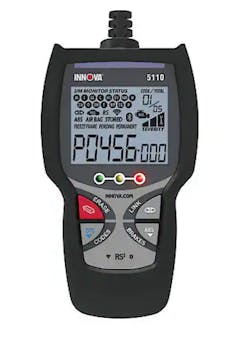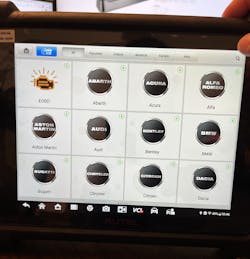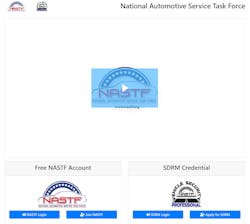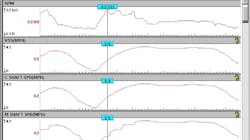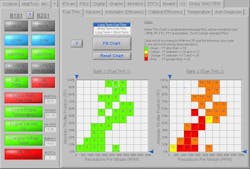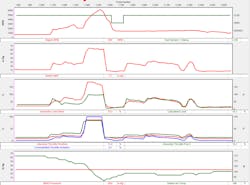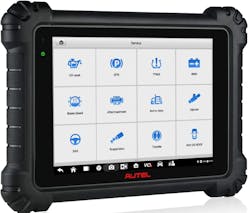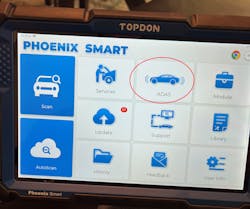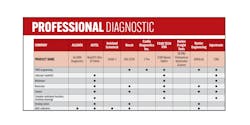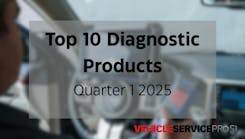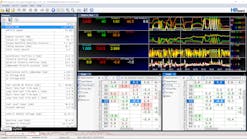A systematic approach to finding the right scan tool
Content brought to you by Motor Age. To subscribe, click here.
What You Will Learn:
• Cost shouldn't be the only factor in choosing which scan tool to purchase
• The scan tool must serve the shop's or technician's needs. Having the most capable tool can be expensive and may not be necessary
• Referencing a Specification Guide allows an apple-to-apples comparison for many different scan tools at once.
As a technician in the industry for about 25 years, I have had my hands on many different scan tools. Many of them were factory tools and many more were aftermarket tools. With the ever-changing advancements in technology, I have seen so many new convenient features implemented that make the scan tool ever more powerful today.
However, one thing is certain. The scan tool will always serve as a liaison between the technician and the vehicle. Regardless of how much or how little capability the tool features, if it doesn’t do what you need it to do, it is not a wise investment.
Cost
Obviously, one of the first items to factor in is how much the scan tool is going to cost. There are functional scan tools that can be purchased for under $200.00. Probably unsurprisingly, the functionality of that tool is likely limited to simple and basic functions, like requests for OBDII stored DTCs (Mode $03) and perhaps the ability to request a list of completed monitors (Mode $06). Although this data is useful, it certainly won’t suffice as the tool to always get the job done, especially for a professional automotive technician. However, a technician needing a simple device to verify that OBD monitors have run to completion would need little more than the capability of a device like this one from Innova (Figure 1). The key is to realize the limitation of the device before making the investment.
Vehicle coverage
Vehicle coverage should be an important factor to consider when choosing a scan tool for obvious reasons. It’s true that scan tools have come a very long way and the coverage they now provide is very extensive compared to how they used to. But be aware that certain scan tools shine brightly within certain car lines, and very dimly (or sometimes not at all) with other car lines. It’s important to have a scan tool that is going to serve you and your shop well in as many conditions as possible (Figure 2). In other words, choose a tool that is going to give you the most “bang for your buck,” and be prepared to add other scan tools that are better suited to specific car lines when called upon.
It’s only fair to mention that with the ground gained regarding the right to repair (R2R) and the availability of factory-level scan tools and service information, these serve as a tremendous supplement to a more general scan tool (Figure 3).
Scanning functions
I have mentioned many times in my previous articles that I see the scan tool as a device that should offer us the ability to view data in a fashion that tells a story. With the data arranged properly, we should be able to easily perform a comparison of:
- Inputs
- ECU processing (response/reaction)
- Outputs
- Default/adaptive strategies
Having this ability will allow us to make diagnostic decisions from the driver’s seat. What is the takeaway? This technique not only guides you to the next logical test but prevents you from performing a multitude of unnecessary tests, such as this Snap-on MODIS capture (Figure 4). In this instance, a slippage is occurring internally to a transaxle at the main shaft. Did I mention all of this is carried out from the driver’s seat and without disassembling a thing?
Added features
Described above are necessities every professional technician needs to consider when purchasing a scan tool. The good news is that almost every scan tool a professional technician will encounter possesses those features. However, those need-to-have features can be complemented by nice-to-have features.
Many scan tools now offer a topological view of the ECUs sharing information on the data bus. This feature is incredibly efficient, as it allows for several time-saving techniques to be carried out. For instance, the tech can see which ECUs are communicating. This is tremendously handy to know when dealing will communication issues. This helps the tech triangulate where a fault is located.
Since the proper data arranged in an adequate format yields diagnostic decisions, better-arranged data may bring a diagnostician to those same conclusions easier and/or more efficiently. By taking the same collected data and arranging it in a different format, a certain pattern may stand out more easily. It’s for those same reasons that pie charts, line graphs, and bar graphs exist in many industries (Figure 5). All are a form of comparative measure but each of the charts expresses different characteristics more easily.
Some scan tools will feature cellular charts data displaying a value at a cross-reference point of two different criteria. Having the ability to see all the possible cross-reference points at the same time (along with correlating data) is displaying not just a story but instead all the chapters of the book simultaneously. This is a great chart to discover trends. An example of this would be one from Automotive Test Solutions and its EScan Elite fuel trim chart (Figure 6).
Another example of a unique data arrangement would be merging graphed data to allow a superimposed view of two or more PIDs. A direct and easy-to-view comparison results and offers a quick view of like PIDs that differ from one another. For instance, is one from an old EASE scan tool (Figure 7).
For instance, viewing actual and desired camshaft position PIDs is a quick “go/no-go” test of the VVT system’s functionality. No need to chase anything else if the two pieces of graphed data remain superimposed throughout the entire operating range of the engine.
Bidirectional controls
The ability to take control of a system’s components allows the technician to virtually split a troublesome system in half, offering a “divide and conquer” strategy. Assume for a moment you are faced with a power window concern with the passenger-front window being nonfunctional in the downward position of the master switch.
After viewing a wiring diagram, a logical approach would be to then view data displaying the command status of the right-front power window. Assuming the command was never issued by the ECU, it’s logical to verify the input request from the master switch. Regardless if the command was received, one would still like to know if the window functions as designed.
Using the bidirectional controls of the scan tool (like this screen capture from Autel) will bypass the switch input and directly command the ECU to roll the window down (Figure 8). Assuming that window then functioned, the integrity of the entire output side of the power window system has been verified. Again, no need for wasted time to disassemble components. The answer can be determined from the driver’s seat.
J2534 functionality
This feature is one that should be particularly considered nowadays; more so if no other such capabilities exist in-house. Locating the source of a fault and properly diagnosing the root cause is important. But if the job can’t be completed due to the inability to place software in barren ECU, you are forced to hire expensive outside assistance or pass the job along to a capable shop.
Keep in mind that in several scenarios, even having the ability to upload the appropriate software may not be enough. Some procedures known as post-programming routines may have to be performed (routines like a throttle angle relearn, steering angle sensor relearn, or some security system functions). Some scan tools will allow the software to upload but have no ability to perform certain post-programming routines. This could render a vehicle inoperative until the routine is complete.
A few scan tool providers even offer remote access ability to aid in these programming and post-flash routines. These paid-for sessions can also be used as a teaching guide to help a programming novice progress.
Export files
Today, many scan tools offer the ability to save data in a format like a PDF or one that is interactive. This allows for the ability to export. Transferring these stand-alone files will allow the data to be analyzed remotely and offer the same abilities (to a PC) as the actual scan tool offers.
How can this come in handy? Many shops are structured with a shop foreman overseeing productivity, dispatching jobs, and providing technical assistance to other technicians requiring it. With the ability to export files, the diagnostician/shop foreman can remain in an office or at a desk. Any technician can be easily trained to capture data and send files to the shop foreman.
With a structure like the above implemented, the technicians addressing the vehicles become the shop’s eyes and ears. The experienced shop foreman/diagnostician becomes the brain not for one tech, but for any of the technicians in the shop. This can be a temporary or even a permanent solution to prevent inaccurate diagnoses. Reducing the need to have several A-techs on board can also be cost-effective.
These same files can be screen-captured and uploaded to free apps like Microsoft Paint, giving the ability to highlight, annotate, or otherwise call attention to certain characteristics of a particular capture. This same capture now becomes priceless training material to add to your archives or to reference for new tech trying to enhance his or her depth of knowledge.
ADAS functionality
Advanced driver assistance systems (ADAS) are prevalent in virtually all vehicles nowadays. After the repair or replacement of certain components, calibration of certain ADAS subsystems must be carried out. Some of these calibrations are carried out dynamically, requiring them to be driven under certain specific operating conditions. Others are carried out statically, requiring objects and specific targets to be appropriately placed, and then registered by the vehicle’s ECU.
In either scenario, the routines or calibrations must be initiated by the scan tool. Displayed here is an example from Topdon Phoenix Smart (Figure 9). These are certain factors to consider, especially given the current and growing prevalence of ADAS and the subsystems and components they encompass.
Scan tool software updates
One thing that many shops and individual technicians fail to consider when purchasing a scan tool is the cost to maintain that tool. Some scan tool software annual upgrades can reach prices nearing $1,000.
It’s important to note or inquire about the consequences of not upgrading a tool when new software is available. In other words, will a lacking software upgrade simply omit new features, or will the scan tool performance degrade or cease to function at all?
Many scan tool companies will offer special deals which may include free software upgrades for a year (or maybe several years). Also, keep in mind that scan tools can be found online anywhere you look. It’s true that many times a lower cost scan tool found online may appear to be authentic but is not manufactured to function properly in the U.S. You may find yourself dead in the water when it comes time to upgrade the software and have nowhere to turn for technical assistance. Be sure to purchase your scan tool from a reputable source, regardless of the potential savings of purchasing online from an unknown source.
Scan tool specification guide
Of the scan tool features mentioned, they are just a few of many. Don’t get yourself overwhelmed; these were merely suggested features to keep in mind to help guide you and your shop to a tool that will be less likely to disappoint.
Understand not one scan tool can do it all. If it could, everyone would own it and it would cost a lot of money. But being sure the tool you choose to go with is based on a decision that considers some of the factors mentioned above is always a wise one.
There has been research done across the industry to help narrow down the decision-making process for you. Information pertaining to many different scan tools can be found in a comparative chart like the one posted annually by Motor Age’s sister magazine, Professional Tool and Equipment News (PTEN) (Figure 10). This chart allows one to easily compare one scan tool to the rest with all the factors mentioned above (and many more). Keeping this information in mind when shopping for a scan tool will steer you out of trouble and likely put one in your hand that will serve you and your shop well.

